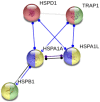HSPA1A, HSPA1L and TRAP1 heat shock genes may be associated with prognosis in ovarian epithelial cancer
- PMID: 31897148
- PMCID: PMC6923843
- DOI: 10.3892/ol.2019.11095
HSPA1A, HSPA1L and TRAP1 heat shock genes may be associated with prognosis in ovarian epithelial cancer
Abstract
Epithelial ovarian cancer (EOC) is the most lethal gynecological malignancy, with the presence of chemoresistance contributing to the poor prognosis. Heat Shock Proteins (HSPs) genes are activated in response to pathophysiological stress and serve a role in a variety of stages in carcinogenesis, acting primarily as anti-apoptotic agents and in chemotherapy resistance in a variety of tumor types. The current study evaluated the HSP gene expression profile in women with ovarian cancer (OC) and their correlation with clinical and pathological aspects of patients with OC. A total of 51 patients included in the current study were divided into four groups: Primary Epithelial Ovarian Cancer (EOC; n=14), metastatic EOC (n=11), ovarian serous cystadenoma (n=7) and no evidence of ovarian malignancy or control groups (n=19). RNA extraction and reverse transcription-quantitative (RT-q) PCR was then performed on the samples obtained. RT-qPCR was performed to compare TNF receptor associated protein 1 (TRAP1), heat shock protein family (HSP) HSPB1, HSPD1, HSPA1A and HSPA1L expression in primary and metastatic EOCs. TRAP1, HSPB1, HSPD1, HSPA1A and HSPA1L gene expression did not differ among groups. HSPA1A, HSPA1L and TRAP1 were revealed to be underexpressed in the primary and metastatic EOC groups, with HSPA1L exhibiting the lowest expression. TRAP1 expression was higher in tumors at stages I/II compared with those at stages III/IV. No correlation was exhibited between HSP expression and age, menarche, menopause, parity, period after menopause initiation, cytoreduction, CA-125 or overall and disease-free survival. HSPA1A was negatively correlated with the risk of mortality from OC. The results indicated that the downregulation of HSPA1A, HSPA1L and TRAP1 could be associated with the clinical prognostic features of women with EOC.
Keywords: gene expression; heat shock proteins; ovarian cancer; prognosis; resistance to chemotherapy.
Copyright: © De Andrade et al.
Figures





Similar articles
-
Overexpression of tumor necrosis factor receptor-associated protein 1 (TRAP1) are associated with poor prognosis of epithelial ovarian cancer.Tumour Biol. 2016 Feb;37(2):2721-7. doi: 10.1007/s13277-015-4112-9. Epub 2015 Sep 25. Tumour Biol. 2016. PMID: 26408177
-
TRAP1 downregulation in human ovarian cancer enhances invasion and epithelial-mesenchymal transition.Cell Death Dis. 2016 Dec 15;7(12):e2522. doi: 10.1038/cddis.2016.400. Cell Death Dis. 2016. PMID: 27977010 Free PMC article.
-
FOXM1 expression is significantly associated with chemotherapy resistance and adverse prognosis in non-serous epithelial ovarian cancer patients.J Exp Clin Cancer Res. 2017 May 8;36(1):63. doi: 10.1186/s13046-017-0536-y. J Exp Clin Cancer Res. 2017. PMID: 28482906 Free PMC article.
-
Stress-Adaptive Response in Ovarian Cancer Drug Resistance: Role of TRAP1 in Oxidative Metabolism-Driven Inflammation.Adv Protein Chem Struct Biol. 2017;108:163-198. doi: 10.1016/bs.apcsb.2017.01.004. Epub 2017 Feb 12. Adv Protein Chem Struct Biol. 2017. PMID: 28427560 Review.
-
Heat shock proteins, cell survival and drug resistance: the mitochondrial chaperone TRAP1, a potential novel target for ovarian cancer therapy.Gynecol Oncol. 2010 May;117(2):177-82. doi: 10.1016/j.ygyno.2009.10.078. Epub 2009 Nov 25. Gynecol Oncol. 2010. PMID: 19942270 Review.
Cited by
-
Identifying Cellular Stress-Related mRNA Changes Induced by Novel Xanthone Derivatives in Ovarian Cancer Cells In Vitro.Pharmaceutics. 2025 Jun 24;17(7):816. doi: 10.3390/pharmaceutics17070816. Pharmaceutics. 2025. PMID: 40733026 Free PMC article.
-
Upregulation of HSPA1A/HSPA1B/HSPA7 and Downregulation of HSPA9 Were Related to Poor Survival in Colon Cancer.Front Oncol. 2021 Oct 26;11:749673. doi: 10.3389/fonc.2021.749673. eCollection 2021. Front Oncol. 2021. PMID: 34765552 Free PMC article.
-
Gene expression and DNA methylation analyses suggest that two immune related genes are prognostic factors of colorectal cancer.BMC Med Genomics. 2021 Apr 28;14(1):116. doi: 10.1186/s12920-021-00966-3. BMC Med Genomics. 2021. PMID: 33910576 Free PMC article.
-
TRAF7 knockdown induces cellular senescence and synergizes with lomustine to inhibit glioma progression and recurrence.J Exp Clin Cancer Res. 2025 Apr 4;44(1):112. doi: 10.1186/s13046-025-03363-1. J Exp Clin Cancer Res. 2025. PMID: 40181456 Free PMC article.
-
The small heat shock protein αB-Crystallin protects versus withaferin A-induced apoptosis and confers a more metastatic phenotype in cisplatin-resistant ovarian cancer cells.PLoS One. 2023 Jan 26;18(1):e0281009. doi: 10.1371/journal.pone.0281009. eCollection 2023. PLoS One. 2023. PMID: 36701406 Free PMC article.
References
-
- du Bois A, Luck HJ, Meier W, Adams HP, Möbus V, Costa S, Bauknecht T, Richter B, Warm M, Schröder W, et al. A randomized clinical trial of cisplatin/paclitaxel versus carboplatin/paclitaxel as first-line treatment of ovarian cancer. J Natl Cancer Inst. 2003;95:1320–1329. doi: 10.1093/jnci/djg036. - DOI - PubMed
LinkOut - more resources
Full Text Sources
Research Materials
Miscellaneous
